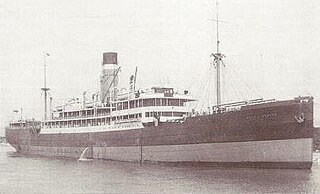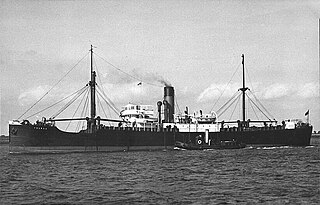
SS Ceramic was an ocean liner built in Belfast for White Star Line in 1912–13 and operated on the Liverpool – Australia route. Ceramic was the largest ship serving the route until P&O introduced RMS Mooltan in 1923.

SS City of Benares was a British steam turbine ocean liner, built for Ellerman Lines by Barclay, Curle & Co of Glasgow in 1936. During the Second World War, City of Benares was used as an evacuee ship to transport 90 children from Britain to Canada. German submarine U-48 sank her by torpedoes in September 1940 with the loss of 260 people out of a complement of 408, including the death of 77 of the evacuated children. The sinking caused such public outrage in Britain that it led to Winston Churchill cancelling the Children's Overseas Reception Board (CORB) plan to relocate British children abroad.

Ellerman Lines was a UK cargo and passenger shipping company that operated from the late nineteenth century and into the twentieth century. It was founded in the late 19th century, and continued to expand by acquiring smaller shipping lines until it became one of the largest shipping firms in the World. Setbacks occurred through heavy losses to its merchant fleet in the First and Second World Wars but were overcome in each case.

SS City of Cairo was a British passenger steamship. She was sunk in the Second World War with heavy loss of life, most after the sinking, but before being rescued.
SS Volo was a British steam cargo ship that was built on Tyneside in 1938 and sunk by a German U-boat in the Mediterranean Sea off North Africa in 1941. 23 people on board the Volo died as a result of the attack.
SS City of Pretoria was a British cargo steamship. She was torpedoed and sunk in the Second World War with heavy loss of life.

SS City of Paris was a steam passenger ship launched in 1920 and completed in 1922 for the Ellerman Lines. She was requisitioned for service by the British government during the Second World War.

SS Clan Alpine was a UK steam cargo liner. She was launched in 1918 and sunk by a U-boat in 1943.

SS City of Venice was an intermediate ocean liner that was launched in 1924 in Northern Ireland for Ellerman Lines. In the Second World War she was a troop ship. In 1943 a U-boat sank her in the Mediterranean, killing 22 of the crew and troops aboard.
Belgian Airman was a 6,959-ton cargo ship which was built by Harland & Wolff Ltd, Glasgow in 1941 for the Ministry of War Transport (MoWT). She was launched as Empire Ballantyne and transferred to the Belgian Government in 1942. She was sunk by a German U-boat on 14 April 1945.
SS Lesbian was a cargo ship built for the Ellerman Lines in 1915. On 5 January 1917 she was shelled and sunk by German U-boat U-35, the most successful U-boat participating in World War I, without loss of life.

HMS Baralong was a cargo steamship that was built in England in 1901, served in the Royal Navy as a Q-ship in the First World War, was sold into Japanese civilian service in 1922 and scrapped in 1933. She was renamed HMS Wyandra in 1915, Manica in 1916, Kyokuto Maru in 1922 and Shinsei Maru No. 1 in 1925.

SS Thurso was a cargo steamship operated by Ellerman's Wilson Line. Thurso was built in 1919 by S. P. Austin & Sons in Sunderland as the War Bramble for the Shipping Controller. Measuring 2,436 gross register tons, the ship had a speed of 9 knots. She was sold to Ellerman Lines while still under construction and remained with the company until lost during the Second World War.

Below is the timeline of maritime events during the Emergency,. This period was referred to as The Long Watch by Irish Mariners. This list is of events which affected the Irish Mercantile Marine, other ships carrying Irish exports or imports, and events near the Irish coast.
SS Mantola was a passenger steamer of the British-India Steam Navigation Company. Launched in 1916 by Barclay Curle & Company, Glasgow, she sailed for less than a year before being sunk by a German U-boat while carrying a large quantity of silver bullion.
SS City of Oxford was a steam merchant ship built in 1926 by Swan, Hunter & Wigham Richardson Ltd., in Newcastle-upon-Tyne and sunk by a German submarine on 15 June 1942. Measuring 2,759 gross register tons she entered service with the Ellerman and Papayanni subsidiary of Ellerman Lines, and served during the Second World War.
SS Equipoise was a Panamanian Cargo ship that was torpedoed by the German submarine U-160 in the Atlantic Ocean 60 nautical miles (110 km) south east of Cape Henry, Virginia, United States on 27 March 1942.
SS City of Bedford was a British cargo steamship. She was launched in 1924 in Sunderland for Hall Line Ltd of Liverpool, a member of the Ellerman Lines group.
SS Florian was an Ellerman Lines cargo steamship that was launched in 1939 and completed in 1940. A U-boat sank her with all hands in 1941 in the Battle of the Atlantic.

SS Stephano was a passenger liner and sealing ship, owned by Bowring Brothers and operated in their Red Cross Line of Arctic steamships. Stephano is most notable for her role in the 1914 Newfoundland Sealing Disaster, under the command of Captain Abram Kean. Stephano was the sister ship to the SS Florizel.











